Pain warns of actual or impending
tissue damage. We use this information to safely navigate our
environment and detect early signs of disease or injury.
Physicians cannot objectively measure patient pain and suffering. Where pain is due to inflammatory, musculoskeletal, or peripheral nerve injury causes, conventional imaging (e.g., CT and MRI scans) cannot confirm patient complaints. Negative test results can frustrate physicians and physical therapists and cause them to conclude that the pain complaints are psychological.
When medical staff distrust their patients, this undermines the therapeutic alliance and results in unnecessary diagnostic testing, poor compliance, and poor clinical outcomes. When physicians and nurses know their patients, they will learn whose pain complaints are attempts to obtain opioids or exaggerated by anxiety and depression and whose reports are credible. Graphic © Romariolen/Shutterstock.com.
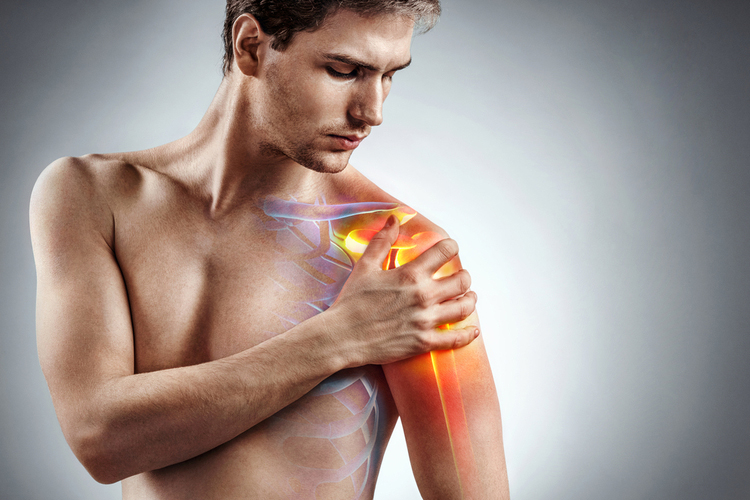
 Listen to a mini-lecture on an Overview of Pain
Listen to a mini-lecture on an Overview of Pain © BioSource Software LLC. Graphic © Barks/Shutterstock.com.
Computer-related disorder (CRD) is a common workplace pain syndrome that may not appear on traditional imaging but can be detected using a one- or two-channel electromyograph.
Here, repetitive motions may interact with factors like immobility and poor ergonomics to produce stiffness, injury, and pain (Peper et al., 2020).

Graphic © Antonio Guillem/Shutterstock.com.

Clients who suffer from CRD have poor awareness of their
posture, immobility, and muscle tension and only seek medical attention when repetitive strain produces injury and
pain. For example, they are unaware of the weight that forward head tilt while talking on a cellphone places on neck and shoulder muscles. Graphic © VectorMine/Shutterstock.com.
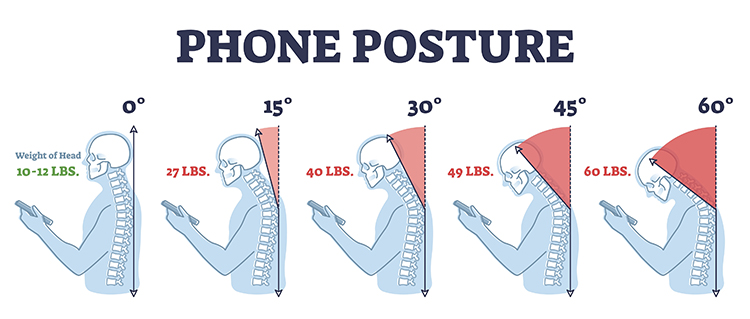
Good ergonomics can reduce CRD. Graphic © Platon Anton/Shutterstock.com.

BCIA Blueprint Coverage
This unit addresses
Chronic neuromuscular pain (IV-C) and
Specific CNS structures (VI-A).

This unit covers Pain Perception, Pain Models, Pain Dimensions, and How Chronic Pain Affects the Nervous System.
Please click on the podcast icon below to hear a full-length lecture.

Pain Perception
Free nerve endings are the body's
primary
nociceptors (pain receptors).

Listen to a mini-lecture on Nociceptors © BioSource Software LLC. Graphic © Designua/Shutterstock.com.
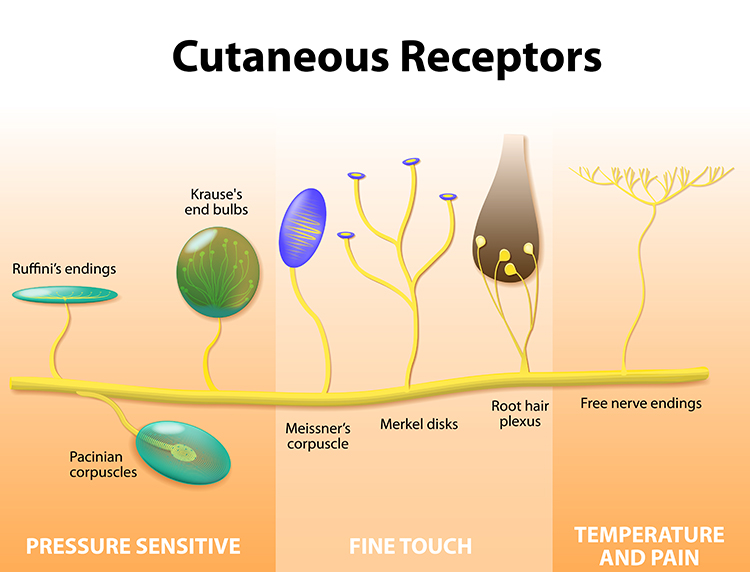
There are three main kinds of
nociceptors: mechanoreceptors (mechanical stress and tissue damage),
chemoreceptors (chemical messengers), and thermoreceptors (temperature
extremes). Nociceptors may be
unimodal
(respond to only one stimulus) or
polymodal (respond to multiple stimuli).
Sherman (2004) estimates that almost 50% of nociceptors in joints and,
possibly the skin, are "silent." These unmyelinated C-fibers only react to stimuli like limb movement
and touch when there is local inflammation. Their activation increases pain two-fold.
Painful stimuli often damage tissue, which causes the release of
substance P, bradykinin, histamine, and prostaglandin. Nociceptors
release the peptide substance P through their many axonal branches in the nearby
skin. Substance P produces
capillary swelling and histamine release from mast cells, sensitizing
other nociceptors located at the injury site. Bradykinin, histamine, and prostaglandin bind to nociceptors
and increase their firing rate,
worsening pain. Histamine and prostaglandins also produce swelling
(Wilson, 2003). Nerve growth factor (NGF) and several proteolytic
(protein-metabolizing) enzymes may play roles in nociception (Breedlove & Watson, 2023).
Research on a family that shared pain insensitivity has shown that a sodium channel may mediate pain in free nerve endings (Cox et al., 2006).
Tissue injury can increase sensitivity to regular stimulation like light touch. The nervous
system can increase pain by lowering its threshold, increasing pain severity, or generating spontaneous pain.
This supersensitivity is called primary hyperalgesia which affects
joints, muscles, or skin that have suffered damage or inflammation. Secondary
hyperalgesia is when it affects the surrounding tissue (Bear et al., 2020).when it affects the surrounding tissue (Bear et al., 2020).
Nav1.7 and 1.8 Sodium Channels
Two sodium channels, Na
v1.7 and Na
v1.8, are particularly important in pain signaling.
Nav1.7 acts as a "fuse," amplifying small depolarizations in sensory neurons, while
Nav1.8 serves as a "firecracker," generating the majority of the electrical current needed for neurons to fire an action potential. Dysfunction in these channels can lead to extreme pain or, conversely, an inability to feel pain. Sodium channel graphic © Juan Gaertner/Shutterstock.com.
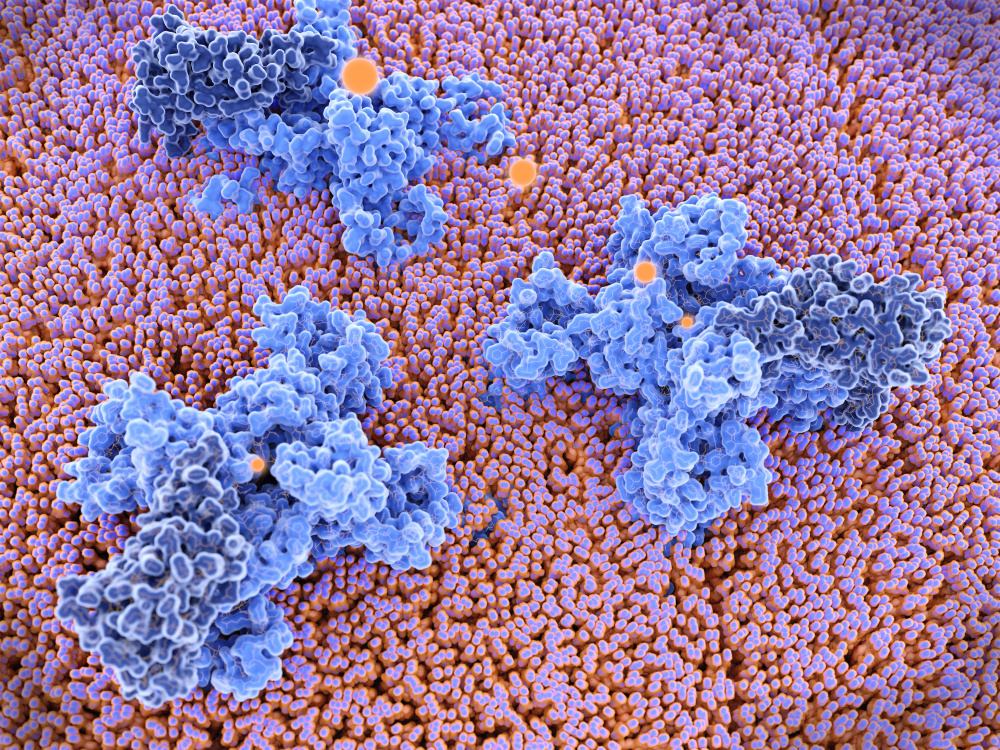
The FDA approved
suzetrigine, a selective Na
v1.8 inhibitor, in 2025 as
Journavx (jor-na-vix) for treating moderate to severe acute pain.
Afferent Axons
Four main types of afferent axons conduct information crucial to pain
perception: A-alpha, A-beta, A-delta, and C-fibers. Primary afferent neurons within
dorsal root ganglia (DRG) synapse with spinal cord dorsal horn neurons. Pain afferent graphic © Blamb/shutterstock.com.
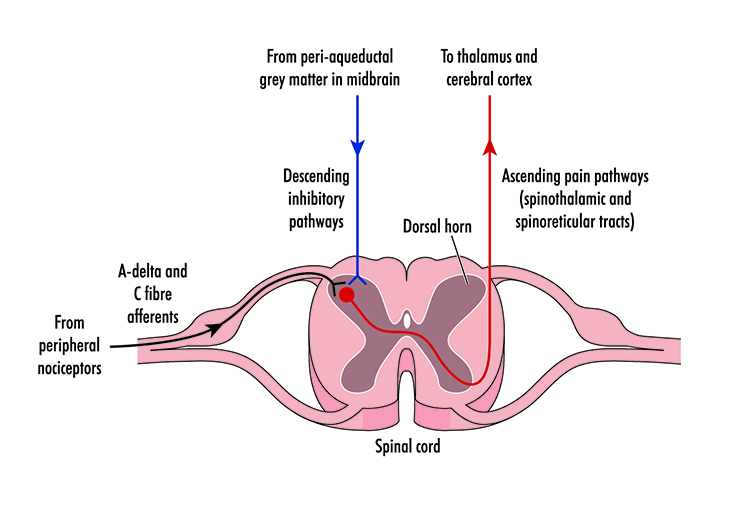
A-delta fibers transmit the first pain signal and largely determine pain sensations. C-fibers convey the second pain signal and influence emotional and motivational responses to pain. A-beta fibers rapidly conduct light touch and are theorized to close Melzack and Wall's pain gate (Taylor, 2021).

Listen to a mini-lecture on Afferent Pain Fibers © BioSource Software LLC.
A-alpha Fibers
A-alpha (Aα) fibers are
large-diameter myelinated fibers that rapidly conduct (80-120 meters per second) muscle
length, contraction force, and light touch stimuli via the
dorsal-column medial-lemniscal and
anterolateral systems.
A-beta
Fibers
A-beta (Aβ) fibers are large-diameter myelinated fibers that quickly
conduct
(35-75 meters per second) light touch stimuli via the
dorsal-column medial-lemniscal and
anterolateral systems.
A-delta Fibers
A-delta (Aδ) fibers are small-diameter myelinated fibers found in
skin and mucous membranes that contain
TRP2 receptors. They strongly
influence the
sensory-discriminative component of pain. Aδ
fibers speedily conduct (5-30 meters per second) pain signals from unimodal
mechanoreceptors via the
anterolateral system to the thalamus and somatosensory cortex. They carry the
first pain signal
that warns that damage has occurred. Clients describe the first pain signal as
sharp, brief pain (Breedlove & Watson, 2020).
C-Fibers
C-fibers are small-diameter unmyelinated fibers located in deep tissue and skin containing TRPVI receptors and strongly influence pain's affective and motivational components. These fibers slowly
conduct (1 meter per second) pain signals from polymodal chemoreceptors and thermoreceptors
to the hypothalamus, thalamus, and cortex. C-fibers travel via the spinothalamic tract to carry the
second pain
signal that reminds the body to protect itself against further
injury. Clients characterize this sensation as
dull, aching pain (Breedlove & Watson, 2023).

Afferent fibers from the nociceptors in the skin and viscera (large internal organs) converge and interact in the
spinal cord. Cross-talk between these axons produces
referred pain
like angina, in which visceral pain due to insufficient oxygen to the heart muscle is
mainly experienced in the upper chest, but sometimes the back, arms, lower jaw, neck, or shoulders (Bear et al., 2020; Heuther et al., 2020).
The combined firing of Aδ and C-fibers results in
double pain, where a patient
experiences two peaks, sharp, brief pain and dull, aching pain (Taylor,
2021).
Changes at the Dorsal Horn
Chronic pain may structurally reroute neuronal connections in the dorsal
horn of the spinal cord. Alterations in the expression of genes like c-
fos
and c-
jun in second-order neurons may change enzyme and
neuropeptide (e.g., nerve growth factor) release and modify synapses with
sensory neurons carrying pain information. Both the structural reorganization of the dorsal horn and
volume transmission (extrasynaptic release) of neurotransmitters may
contribute to the spread of pain beyond the site of injury (Ranney,
2001). Dorsal horn graphic © Designua/Shutterstock.com.
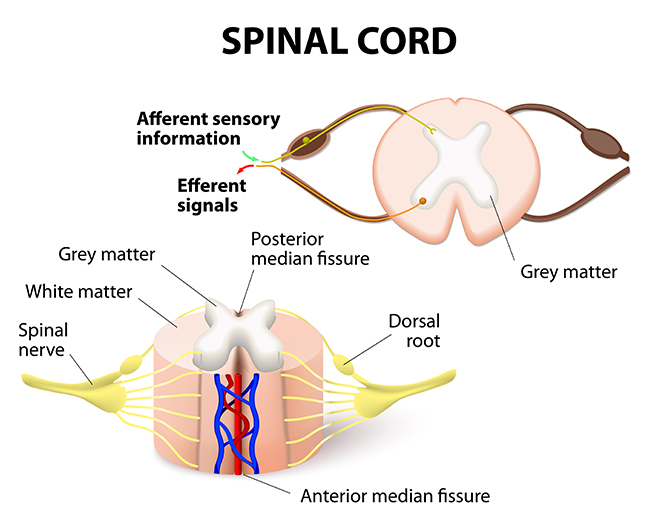
Coull and colleagues (2005) propose
that damage to sensory neurons activates
microglia (glial immune cells) that enclose the synapse between pain
afferents and dorsal horn neurons.
These microglia release
BDNF
(brain-derived neurotrophic factor). Microglia graphic © ART-ur/shutterstock.com.
.jpg)
Microglial BDNF release amplifies pain
BDNF
reverses pain inhibition by
neurons that release GABA and glycine in lamina I of the spinal cord,
where several pain pathways begin. BDNF alters the distribution of
anions (mainly Cl
-) in sensory
neurons that transmit pain information.
BDNF reverses dorsal horn neurons' response to GABA and glycine, activating them. When GABA and glycine bind to
receptors on dorsal horn neurons, they depolarize them and amplify
pain transmission (Coull et al., 2005; Inoue & Tsuda, 2018; Milligan & Watson, 2009). Graphic © Blamb/Shutterstock.com.
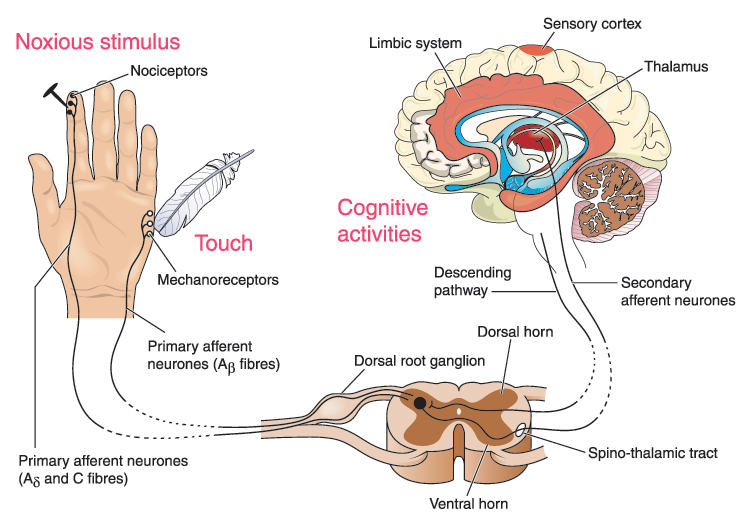
The dramatic increase in dorsal horn neuron activity overwhelms the thalamus with pain messages (Breedlove & Watson, 2023). Thalamic overactivation results
in
allodynia, a neuropathic pain syndrome where nonpainful stimuli, like light
touch, elicit severe pain.
Cluster firing may mediate spontaneous pain
Research with mice raises the possibility that peripheral nerve injury can cause abnormal
sympathetic nerve growth in the dorsal root ganglion. Cluster firing of these neurons may generate unpredictable paroxysms of spontaneous pain in chronic pain patients (Zheng et al., 2021).
Glutamate and substance P worsen pain
Sensory fibers release glutamate to excite spinal cells in the dorsal horn. They also release substance P
(peptide) to postsynaptic neurons during more intense pain, resulting in dendritic remodeling, possibly
influencing pain perception (Kalat, 2019; Li & Tator, 2000).
Widespread Pain-Signaling By Glial Cells
In addition to amplifying pain at the dorsal horn, glial cells help to regulate the body's neuroinflammatory system. Their activation in the spinal cord releases chemical messengers like d-serine and tumor necrosis factor (TNF) into circulating cerebrospinal fluid. Elevated d-serine and TNF levels induce long-term potentiation (LTP), a form of learning, which amplifies pain at distant synapses.
Wounds and opiates administered for analgesia may produce glial overactivation. When drug addicts withdraw from narcotics, this may activate these cells, resulting in excruciating pain throughout the body. Chronic stress, the environment, lifestyle, disorders like Alzheimer's, anxiety, depression, diabetes, and multiple sclerosis may overactivate glial cells and dysregulate the neuroinflammatory system.
This new form of LTP may contribute to allodynia and pain hypersensitivity over an extensive area of the body (Kronschläger et al., 2016). Graphic © Artem Furman/Shutterstock.com.

Trigger Point Mechanisms
Trigger
points are hyperirritable regions of
taut bands of skeletal muscle in the muscle belly or associated
fascia (connective tissue). Graphic © Naeblys/Shutterstock.com.
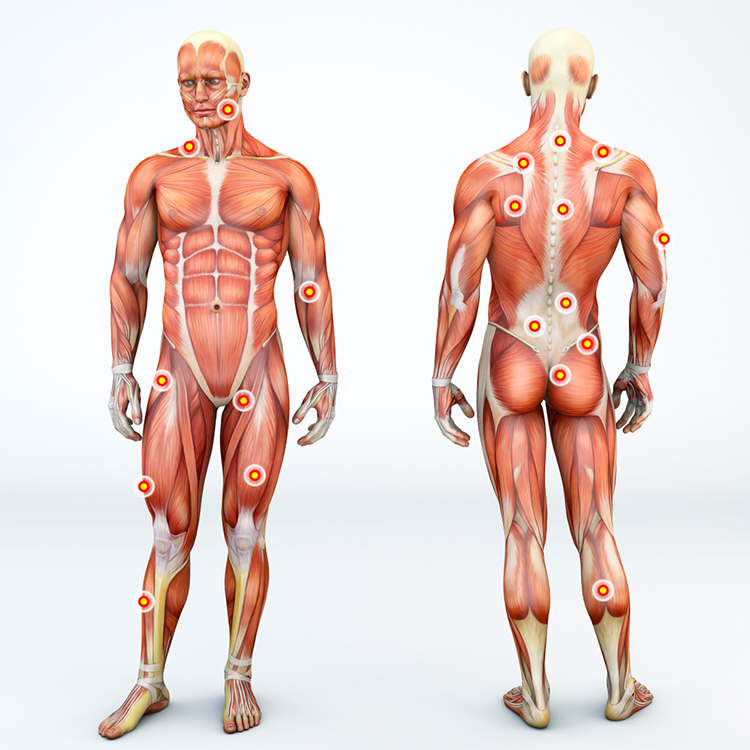

Listen to a mini-lecture on Trigger Points © BioSource Software LLC.
Pressure on
trigger points is painful. Trigger points can produce
referred (remote)
pain and tenderness, motor dysfunction, and
autonomic changes. Trigger
points cannot be detected using SEMG electrodes but can be identified
using needle EMG electrodes and palpation (examination by feeling or
pressing with the hand). Graphic © Alila Medical MediaShutterstock.com.
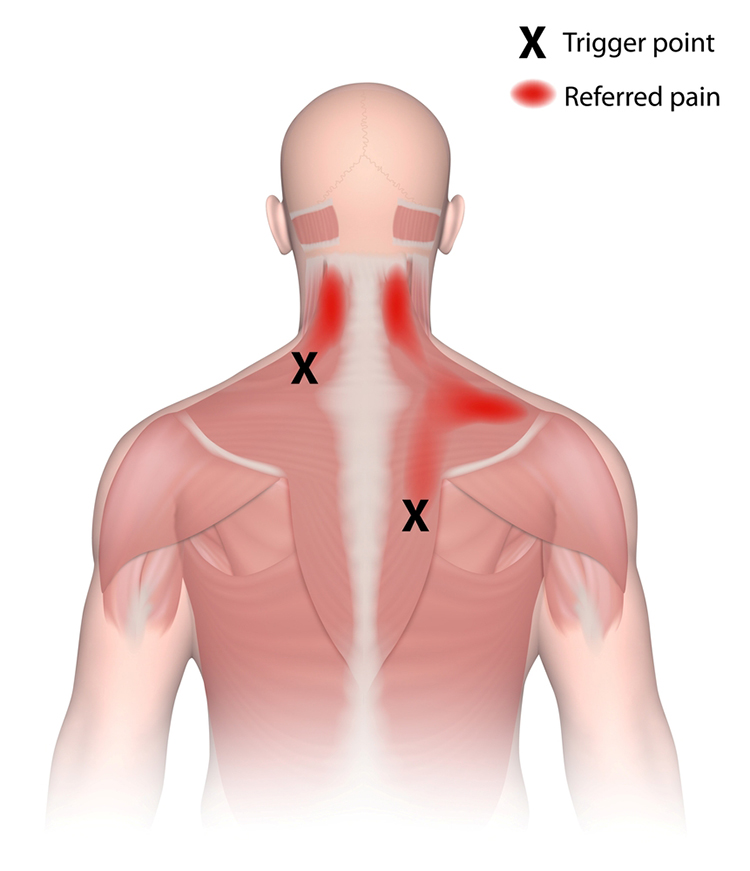
Hubbard and Gevirtz
have proposed that sympathetically-mediated muscle spindle spasm
may be the primary
local mechanism in myofascial pain. An important implication of this
theory is that muscle spindles may be activated by stress and anxiety.
Muscle spindles detect muscle length,
tension, and pressure. The sympathetic branch activates muscle spindles when epinephrine binds to
α-1 adrenergic receptors. EMG electrodes reveal muscle spasm in the
affected
muscle fiber, shown by high inserted EMG amplitudes, while nearby
fibers in the same muscle are electrically silent. Consistent with this
model,
α-1 adrenergic
antagonists (phentolamine and phenoxybenzamine), but not curare, can terminate intrafusal muscle spasms.
Gevirtz (2003) contends that intrafusal muscle spasm accounts for most chronic pain variance. In contrast, neurological factors that influence afferent pain pathways account for a minority of this variance. Muscle spindle graphic by Balazs Sonkodi, Istvan Berkes, and Erika Koltai on Wikimedia Commons. This file is licensed under the Creative Commons Attribution 4.0 International license.

Caption: Three positions of the muscle spindle. (1) Relaxed muscle spindle: the more relaxed the muscle spindle is, the more relaxed the fluid cavity becomes; (2) Stretched muscle spindle: when the muscle spindle stretches, the fluid cavity flattens with uncompressible fluid inside, resulting in more compression and firing of the nerve terminals; (3) Excessively stretched muscle spindle: uncompressible fluid entraps and causes microinjury to the nerve terminals due to the superposition of compression when repetitive eccentric exercise is executed in an unaccustomed or strenuous way.
Gevirtz's (2003)
mediational model of muscle pain
proposes that lack of assertiveness and resultant worry each trigger
sympathetic activation. Increased sympathetic efferent signals to muscle spindles and overexertion can produce a spasm in muscle spindle intrafusal fibers, increasing muscle spindle capsule pressure and causing myofascial pain.

Pain Pathways
There is a complex dynamic interaction between
ascending pathways that distribute pain information to the
brain and
descending pathways that
modulate (facilitate or inhibit) incoming pain signals.

Listen to a mini-lecture on Pain Pathways © BioSource Software LLC.
In theory, disruption of the balance
between the ascending and descending pathways can result in functional
and structural changes in the central nervous system that produce chronic
pain.
Ascending Pathways
The
dorsal-column medial-lemniscus and
anterolateral systems are
the two major ascending somatosensory pathways. Both systems transmit
information from peripheral receptors to the brain over a three-neuron
pathway that includes a primary afferent axon, a secondary projection
neuron, and a tertiary neuron whose cell body lies in the thalamus. Pain pathway graphic © Blamb/shutterstock.com.
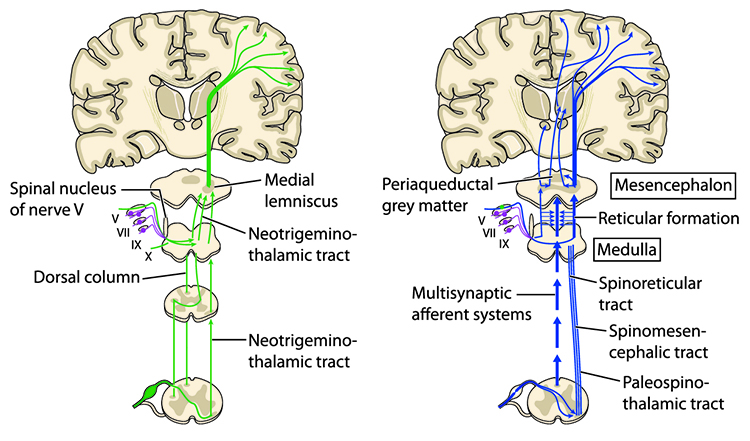
Caption:
Pain information conducted by Ad and C-fibers travels to the brain via the anterolateral system. These afferents cross the midline and ascend the spinal cord before distributing information to brainstem sites, the thalamus, and cortical areas, including SI, the cingulate cortex, and the insula.
Interneurons in these ascending pathways receive and modulate messages from nociceptors. A single interneuron
may communicate with thousands of other interneurons via excitatory and inhibitory synapses. Chronic pain can
modify these complex interneuron networks through repeated stimulation that sensitizes them to innocuous
stimuli. This is mainly a problem when localized inflammation does not remit. In
wind-up,
a patient may continue to experience pain after an injury has healed because interneurons continue to activate
each other in the absence of peripheral pain signals (Sherman, 2004).
Dorsal-Column Medial-Lemniscus System
The
dorsal-column medial-lemniscus system distributes touch (fine tactile
and vibratory) and proprioceptive (joint
and limb position) information to the somatosensory
cortex. Most sensory neurons that contribute to this system have very
small receptive fields that allow precise spatial localization and
project to the spinal cord using large-diameter myelinated A
β fibers.
Visceral (large internal) organs provide pain information via
C-fibers that enter the spinal cord and synapse on dorsal horn neurons.
Anterolateral System
The
anterolateral system (ALS) distributes
pain and temperature information to the somatosensory cortex and other
brain regions. Dorsal horn axon synapses with various brain neurons allow these areas to facilitate or inhibit pain (Advokat et al., 2022).
The anterolateral system comprises the spinothalamic,
spinoreticular, spinomesencephalic, and spinohypothalamic tracts. It receives information about the face from the three branches of the
trigeminal nerve.
The spinothalamic tract distributes sensory information regarding pain. The spinoreticular tract conveys motivational and emotional information, including suffering.
The primary afferent axons that comprise the ALS are
small-diameter Aβ and C-fibers. Free nerve endings synapse on spinal neurons in the dorsal horn. Anticonvulsants like gabapentin and pregabalin inhibit these axons' firing to interfere with pain signal transmission to the spinal cord (Advokat et al., 2022).
Afferent axons probably use glutamate to excite spinal cells in the dorsal horn. They also release substance P, a neuropeptide. Glutamate antagonists like Ketalar can block pain without depressing breathing or contributing to opioid addiction. Cannabis reduces pain by stimulating endogenous cannabinoid receptors (CB1 receptors).
Postsynaptic neurons take up substance P and remodel dendrites, affecting pain perception. Microglial cells release chemicals that make the dorsal horn neurons hyperexcitable and cause chronic pain. Following remodeling, GABA release increases pain instead of reducing it. Unless physicians aggressively control pain following acute injury, the remodeled dorsal horn circuitry may become a pain amplifier that results in chronic pain.
Since the
sensory neurons contributing to this system have large receptive
fields, spatial localization is imprecise. The majority of these sensory neurons synapse within the spinal
cord. Most of their second-order neurons cross over and ascend to the thalamus via the
contralateral anterolateral spinal cord. A minority of these neurons do not
cross over and, instead, ascend on the same side.
Four Anterolateral System Tracts
The spinothalamic tract (also called
the neospinothalamic tract) targets
the ventral posterior nucleus (VPN) of the thalamus, like the
dorsal-column medial-lemniscus system. VPN neurons project to
the corresponding somatosensory cortical region. This tract conveys
information about pain and temperature.
The spinoreticular tract (also called
the paleospinothalamic tract) targets the thalamus' ventral posterior nucleus (VPN), like the dorsal-column medial-lemniscus system. Axons from these thalamic nuclei project to the
anterior cingulate, amygdala, and hypothalamus. This tract may contribute
to arousal and convey
information about our emotional response to pain, including suffering.
The spinomesencephalic tract travels with the spinotectal tract and targets
the periaqueductal gray
(PAG), locus coeruleus, and tectum. This tract may convey information
concerning motivational and emotional responses to pain.
The spinohypothalamic tract bypasses
the reticular formation and projects to the hypothalamus, amygdaloid
complex, nucleus accumbens, and septum. This tract may contribute to our
autonomic, neuroendocrine, and emotional responses to noxious stimuli.
Trigeminal Nerve
The
trigeminal nerve projects pain
and temperature information concerning the face to the same thalamic
nuclei targeted by the spinothalamic and spinoreticular tracts.
The thalamic nuclei targeted by these tracts, in turn, project pain and temperature information to
SI, SII, the posterior parietal cortex, and other brain regions
(Kingsley, 2000). The diagram shows the connections between the pulvinar (bottom right) and reticular nuclei (bottom left) of the thalamus and the cortex © Elsevier Inc. - Netterimages.com.
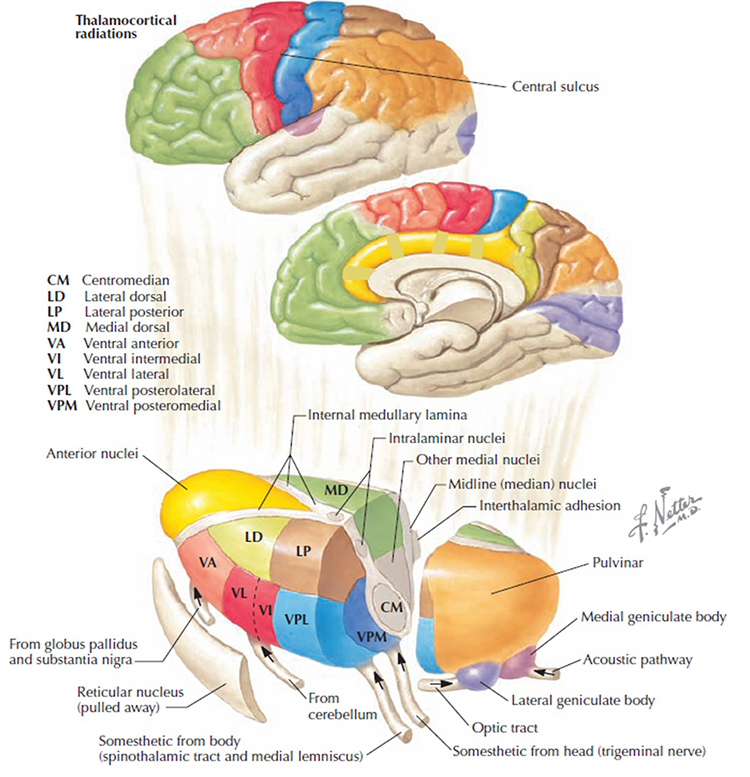
Thalamic projections to the posterior insula, basal ganglia, and cingulate cortex play an essential role in constructing our pain experiences and placebo effects (Zunhammer et al., 2021). The
posterior insula is implicated in the somatosensory aspects of pain (Lu et al., 2016). The
basal ganglia are involved in our motivation and actions in response to pain. The
cingulate cortex (shown in gray) integrates
ascending pain messages (Breedlove & Watson, 2020). Opioids reduce these structures' emotional response to pain and the resulting suffering without altering sensory transmission (Advokat et al., 2022). Graphic ©Blamb/Shutterstock.com.
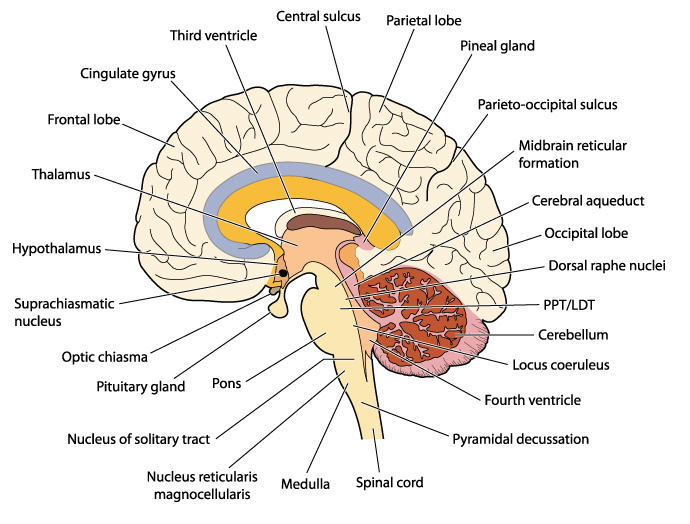
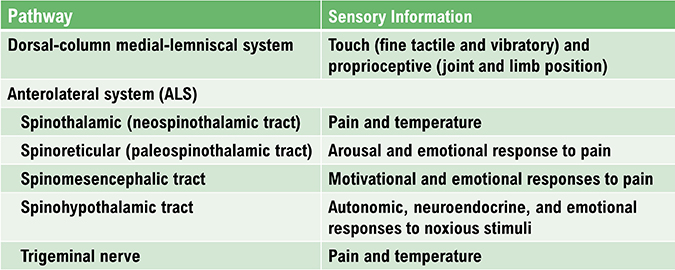
Descending Pathways
Several descending systems modulate (increase or decrease) the transmission of pain information.
The cerebral cortex modulates pain
transmission via projections to the thalamus and reticular formation. The
locus coeruleus more directly modulates pain transmission by its projections to the spinal cord's dorsal horn, the site of ascending pain signals.
Periaqueductal gray (PAG) axons form
excitatory synapses on neurons located in the
nucleus raphe magnus (NRM) and the
nucleus reticularis paragigantocellularis (NRPG) in the
medulla. The NRM and NRPG are part of the reticular formation. Their
axons enter the spinal cord and synapse on interneurons in the dorsal
horn.
Ranney (2001) identified five bidirectional loops between the reticular formation and the
spinal cord (spinoreticular and reticulospinal) on each side of the body.
These loops transmit information in both directions and can facilitate or inhibit pain transmission. They connect the spinal
cord to the dorsolateral pons, medulla, and hypothalamus. Stimulation of
these loops can affect pain transmission from hours to days.
Tricyclic antidepressants increase descending pathways' serotonin and norepinephrine, gating ascending pain signals (Advokat et al., 2022).
Most NRM neurons excite spinal cord interneurons by releasing serotonin.
These interneurons, in turn, inhibit C-fibers by releasing enkephalin,
which binds to their terminal buttons and reduces their release of
transmitter. This inhibition involves a process called presynaptic inhibition.
NRPG neurons excite spinal cord interneurons by releasing norepinephrine. These interneurons inhibit neurons that project through a non-opioid polysynaptic pathway to the thalamus.
PAG neurons are influenced by diverse projections, including the
ascending spinomesencephalic tract of the ALS and descending axons from
the cerebral cortex, thalamus, and hypothalamus.
Mu (μ)
opioid receptors on PAG neurons allow both opioids that are released
synaptically, extra-synaptically via volume transmission and through
drug administration to influence their activity (Kingsley, 2000).
Endocannabinoids, which are related to THC from marijuana, can
block the transmission of pain signals from the periphery to the dorsal horn of the spinal cord (Kalat, 2019).
Gating Pain
Melzack and Wall (1965) were the first investigators to explain why
people respond differently under different circumstances to
identically painful stimuli. Their Gate-Control
Theory of Pain represented an early pattern theory of how we react to and controls response to painful stimuli.

Listen to a mini-lecture on Gate-Control Theory © BioSource Software LLC.
Melzack and Wall conceptualized pain as a cutaneous (skin) sensation that arises from somatosensory signals
converging on spinal cord dorsal horn neurons that communicate
with an adjustable pattern detector in the thalamus and cortices.

Caption: Ron Melzack
The Gate-Control Theory was the first model to propose cognitive-emotional mediation of pain and
interaction between ascending and descending pathways. Their theory replaced the
simplistic one-way model where pain signals ascend from the spinal cord
to the brain.
In the Gate-Control Theory of Pain, C-fibers carry information about pain to neurons in the substantia gelatinosa, located in the spinal cord's dorsal horn.
The illustration below © 2003 Josephine Wilson.
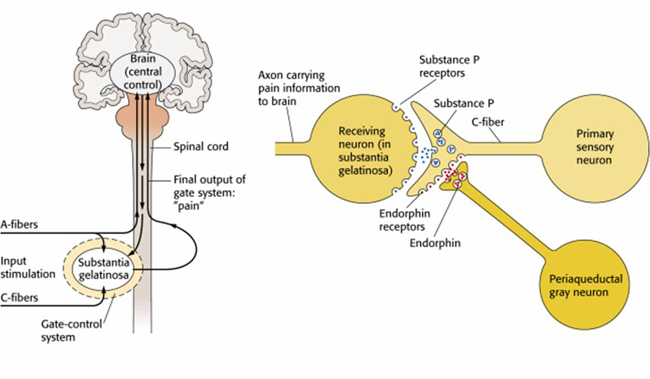
From the substantia
gelatinosa, information about pain is relayed to the brainstem and then to
the cerebral cortex, where pain is consciously experienced.
Gatchel (2005) believes that the pain
"gate" is opened by pain-centered thoughts and negative thinking;
negative feelings like anger, helplessness, hopelessness, sadness, and
stress; and behaviors like inactivity, insufficient sleep, poor diet, and
smoking.
Axons from the periaqueductal gray (PAG) and the periventricular
gray areas release pain-inhibiting neurotransmitters in the substantia gelatinosa to
"close the gate."
Aβ fibers that carry tactile
information and coping behaviors can "close the gate" to stop pain
information from reaching the brain (Gatchel, 2005).
One significant advancement is the integration of synaptic plasticity mechanisms into the original framework. Recent studies have highlighted the roles of NMDA receptor-mediated synaptic plasticity and intrinsic neuronal plasticity in modulating pain pathways. These findings suggest that changes in synaptic strength and neuronal excitability can influence the gating mechanism, thereby affecting pain perception. Such plastic changes can lead to persistent pain states, as the nervous system becomes sensitized to nociceptive inputs.
Furthermore, the original Gate Control Theory has been refined to account for the influence of descending pathways from the brain that can modulate the gating mechanism in the spinal cord. These descending controls can either amplify or dampen pain signals, providing a neurophysiological basis for the role of psychological factors such as attention, emotion, and expectation in pain perception. This understanding has led to therapeutic approaches that target these descending pathways to manage pain more effectively.
Pain receptors use substance P to signal tissue damage and pain
to the central nervous system. Substance P is released by small-diameter,
unmyelinated C-fibers in the substantia gelatinosa and excites neurons
whose axons carry information about pain to the brain. However, centers
in the cerebrum and brain stem project axons down to the substantia
gelatinosa. These axons can release
endorphins and
non-opiate
transmitters like
norepinephrine and serotonin to produce
analgesia (the absence of pain) by
inhibiting C-fiber release of substance P in the substantia gelatinosa
via presynaptic inhibition (Wilson, 2003).
The stress response can produce analgesia that is not reversed by the
opioid-blocker
naloxone. ACTH, corticosterone, and neurotensin can reduce
pain without releasing opioids.
Treatments for pain appear to activate the endorphin, non-opiate pain-inhibitory systems, or both. These treatments include drugs, counterirritation, acupuncture, transcutaneous
electrical nerve
stimulation (TENS), and hypnosis.
Neural Plasticity and Phantom Limb Pain
The topographical map of the primary somatosensory cortex is
plastic and can be reorganized. The topographical organization of the
primary somatosensory cortex is altered following the amputation of a limb.
The ability of the primary somatosensory cortex to reorganize may
contribute to the experience of chronic pain, especially a type of
chronic pain known as
phantom limb pain.
In phantom limb pain, a person who has had a limb amputated continues to
feel pain in the missing limb long after it has been amputated. The
severity of phantom limb pain is directly related to the extent of the
reorganization of the somatosensory cortex, with more pain associated
with more extensive cortical reorganization (Wilson, 2003).
Pain as a Homeostatic Emotion
Craig (2003) proposed, in contrast
to pattern theorists like Melzack and Wall, that pain is a unique
homeostatic emotion concerned with preserving the body. He
challenged the Gate-Control Theory of Pain by observing that neither
somatosensory cortical damage nor stimulation alters pain. Chronic
pain can be reduced by stimulating the somatosensory thalamus. In primates, pain is a feeling produced by separate sensory channels
that directly project via a
central homeostatic
afferent pathway from the thalamus to the cortex. These
thalamocortical projections help us construct an image of the body's
current physiological state (sensation) and directly activate the limbic
motor cortex (affective motivation).
A sensation is
generated by the
interoceptive and anterior
insular cortex, "the feeling self." Affective motivation is
produced by the
anterior cingulate cortex (ACC),
the "behavioral agent." Thus, pain consists of a specific sensation
and affective motivation to initiate autonomic and motor responses to a
condition that threatens body integrity.
Pain Perception
Pain perception has sensory-discriminative, motivational-affective, and
cognitive-evaluative dimensions.

Listen to a mini-lecture on Pain Perception © BioSource Software LLC.
The
sensory-discriminative component of pain perception, which
determines what the pain feels like (dull
aching or sharp), is processed in the
secondary
somatosensory cortex.
The
motivational-affective component,
which determines emotional or physical pain's unpleasantness, is processed in the
anterior cingulate
cortex of the frontal lobe.
Finally, the
cognitive-evaluative
component, which determines what the
pain means (GI distress or angina), is processed in the
prefrontal cortex and
the
insula (Wilson, 2003).
Check out Christopher deCharms' TED Talk,
A Look Inside the Brain in Real Time.
Eisenberger, Lieberman, and Williams (2003) used a functional MRI (fMRI) to
study the brains of subjects who believed that two
companions playing an online baseball simulation suddenly dropped
them from the game. Their emotional distress activated the
anterior
cingulate cortex, which evaluates the unpleasantness of both emotional and physical pain. The more distress subjects feel, the greater the activity in anterior cingulate cortex.
Participants taking Tylenol reported fewer hurt feelings than those taking a placebo, and there was less activation of the anterior cingulate.
Our perception of pain is greatly influenced by expectancy. Watch Joshua W. Pate's
Mysterious Science of Pain.
Since pain is a complex perception, clinicians cannot objectively measure a patient's pain. In the absence of evidence of traumatic injury, this can lead to family members' and caregivers' mistaken belief that the pain is imaginary or exaggerated. Patients can subjectively rate their pain from 0 to 10 using analog scales. Graphic © EgudinKa/Shutterstock.com.
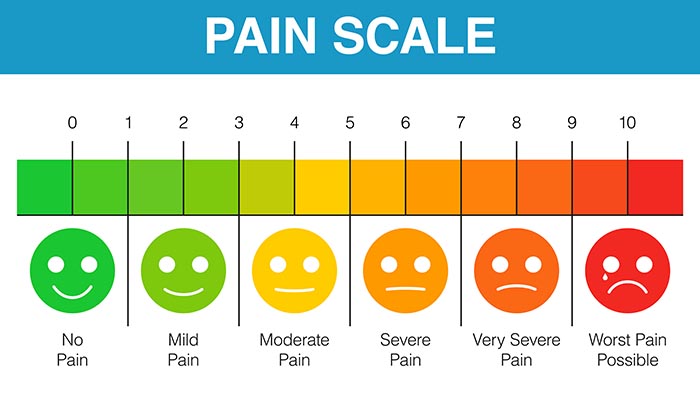
Pain Models
The biopsychosocial and dynamic pain connectome models are two influential pain models.

Listen to a mini-lecture on Pain Models © BioSource Software LLC. Graphic © Image Point Fr/Shutterstock.com.

Biopsychosocial Model
The biopsychosocial model proposes
that the interplay of physical pathology, psychological processes, and social
and economic factors determines each patient's unique pain experience,
pain behavior, and physical disability. In
Gatchel's (2005) view, "the biopsychosocial model is now
viewed as the most heuristic approach; it appropriately conceptualizes
pain as a complex and dynamic interaction among physiologic, psychologic,
and social factors that often results in, or at least maintains, pain"
(p. 23).
The Fear-Avoidance Model
The
fear-avoidance model (FAM) is a psychological framework that explains how individuals develop chronic pain through maladaptive responses to pain-related fear. Originally proposed by Lethem et al. (1983) and later refined by Vlaeyen and Linton (2000), the model describes a cycle in which individuals who interpret pain as threatening may engage in avoidance behaviors, leading to physical deconditioning, increased disability, and heightened pain sensitivity. In contrast, those who view pain as non-threatening are more likely to maintain normal activity levels and recover.
FAM expands the biopsychosocial model by providing a mechanistic explanation for the psychological and behavioral aspects of pain chronification. While the biopsychosocial model broadly integrates biological, psychological, and social influences on pain, FAM offers a specific pathway through which cognitive and emotional factors contribute to long-term pain outcomes. It emphasizes the role of catastrophic thinking, fear of movement (kinesiophobia), and avoidance behaviors as key determinants of pain persistence, highlighting how pain-related distress can drive neural plasticity and reinforce the chronic pain experience (Vlaeyen & Linton, 2012).
Recent developments in pain neuroscience have further refined FAM by incorporating insights from predictive coding and network-based models of pain. Functional neuroimaging studies suggest that fear-avoidance behaviors are linked to hyperactivity in the amygdala, anterior insula, and prefrontal cortex, which regulate pain-related fear and learning (Meulders, 2019). Additionally, emerging evidence shows that persistent avoidance behaviors can disrupt the dynamic interactions of the default mode network and salience network, reinforcing pain expectations and emotional distress (Kucyi & Davis, 2015).
In clinical applications, FAM has led to targeted interventions such as graded exposure therapy and cognitive-behavioral therapy (CBT), which aim to reduce fear-avoidance cycles by gradually reintroducing feared movements and modifying maladaptive beliefs about pain. These approaches have been shown to improve functional outcomes in patients with chronic musculoskeletal pain (Vlaeyen et al., 2016).
By integrating cognitive-affective mechanisms into the broader biopsychosocial framework, the fear-avoidance model has enhanced our understanding of chronic pain and informed more effective interventions. It underscores the importance of addressing psychological factors in pain management, shifting the focus from purely biomedical approaches to holistic, interdisciplinary treatments.
Dynamic Pain Connectome Model
The
dynamic pain connectome model offers a comprehensive perspective on how pain is processed in the brain, emphasizing the fluid and interconnected nature of neural networks involved in pain perception (Kucyi & Davis, 2015). Traditional models often focused on static representations of specific brain regions associated with pain. In contrast, the dynamic pain connectome model posits that pain perception arises from the continuous and dynamic interactions among multiple brain networks, which fluctuate over time and across different contexts.
Central to this model is the understanding that spontaneous fluctuations in brain activity significantly influence pain experiences. Research indicates that even in the absence of external stimuli, the brain exhibits intrinsic activity patterns that can modulate the perception of pain. These spontaneous neural activities suggest that the brain's resting-state networks play a crucial role in how pain is experienced and processed.
The model also highlights the involvement of large-scale brain networks beyond traditional pain pathways. Notably, the
salience network, which detects and filters salient stimuli, and the
default mode network, associated with self-referential thoughts and mind-wandering, are integral to pain processing (Menon & Uddin, 2010). The dynamic interplay between these networks and classical nociceptive pathways underscores the complexity of pain perception and its modulation by cognitive and emotional factors.
.jpg)
Caption: Brain networks: One atlas with seven networks. Seven brain networks derived from resting-state fMRI data were adapted from Schaefer et al. (2018).
Empirical studies have provided evidence supporting the dynamic pain connectome model. For instance, research has demonstrated that fluctuations in functional connectivity within and between these networks correlate with variations in pain intensity and perception. These findings suggest that pain is not solely a result of static neural activations but is profoundly influenced by the temporal dynamics of brain network interactions.
In summary, the dynamic pain connectome model advances our understanding of pain by framing it as an emergent property of dynamic and context-dependent brain network interactions. This perspective opens new avenues for research and potential therapeutic interventions targeting the modulation of these network dynamics to alleviate pain.
Pain Dimensions
Acute versus chronic pain and respondent versus operant pain are two critical pain dimensions.

Listen to a mini-lecture on Pain Dimensions © BioSource Software LLC.
Graphic © sirtravelalot/Shutterstock.com.

Acute Versus Chronic Pain
Acute pain is pain associated with
tissue damage, involves brief, intense, unpleasant sensations, warns of
potential injury, and may produce transient anxiety. The pain experience
is easily recognized and localized. Healing and treatment are effective
about 90% of the time.
Chronic pain is pain not caused by cancer that has
persisted for at least 3 months and has not responded to medical treatment (Advokat et al., 2022). Although other authors (e.g., Taylor, 2021) cite 6 months, injury healing is often complete, and opioids manage non-cancer pain less effectively within three months.
Nonsteroidal anti-inflammatory drugs (e.g., ibuprofen) provide better non-cancer pain control than opioid analgesics when pain becomes chronic.
There
is a weak relationship between physical findings and pain severity.
Chronic pain disrupts patients' daily activities. They may become
preoccupied with their pain, increase health care utilization (testing,
treatment, and medication), and present with anger, depression, and
frustration. Check out Elliot Krane's TED Talk,
The Mystery of Chronic Pain.
Episodic or
recurrent pain is pain that has recurred for more than 3
months. Like acute pain, these episodes are brief. However, these
episodes often produce psychological distress (like chronic pain), and
patients may present with anxiety, depression, helplessness, and stress.
While pain medication may reduce pain severity, it usually does not
prevent recurrent episodes. Prolonged episodes of low back or headache
pain may resemble chronic pain syndromes in symptoms, psychological
distress, and degree of incapacitation (Gatchel, 2005).
Respondent Versus Operant Pain
Respondent pain is pain due
to an identifiable stimulus, like a dental drill. This pain does not
require previous learning.
Operant pain results from prior reinforcement of pain behaviors by the environment (secondary gain).
How Chronic Pain Affects the Nervous System
Chronic pain damages spinal cord neurons and the brain.

Listen to a mini-lecture on Chronic Pain Effects © BioSource Software LLC. Graphic © EgudinKa/Shutterstock.com.
How Chronic Pain Affects Spinal Cord Neurons
Unremitting pain in patients diagnosed with arthritis, cancer, diabetes, and nerve trauma lowers their spinal cord neurons' firing threshold. Weak somatosensory stimulation, like a light touch, causes
spinal cord neuron firing and body-wide pain (Melton, 2004). Graphic © James Steidl/Shutterstock.com.
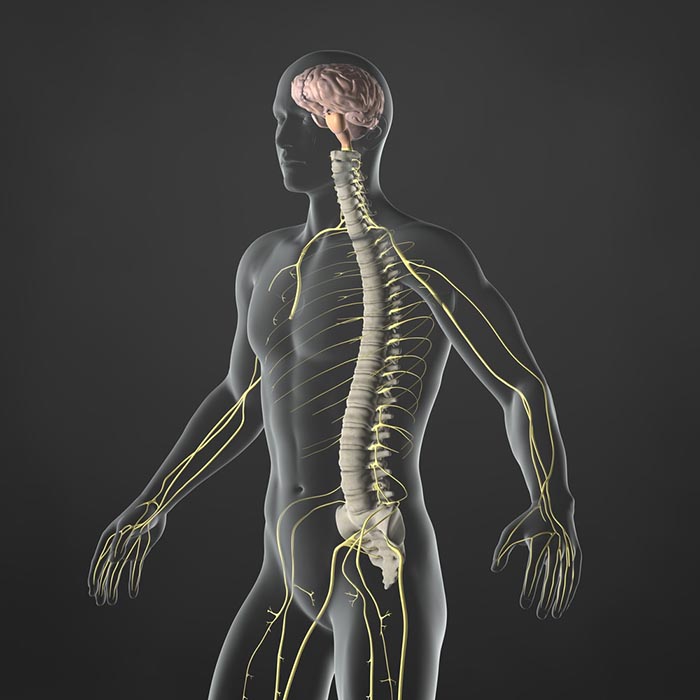
Chronic Pain Damages the Brain
Chronic pain can produce brain atrophy and impair judgment.
Apkarian
used magnetic imaging to compare the prefrontal cortex's overall volume and gray matter density of chronic low back pain patients and healthy volunteers. The low back pain patients showed 1.3 mm
3 more dorsolateral prefrontal cortex
shrinkage a year than usual. Their shrinkage was comparable to 10-20 years of normal aging (Apkarian et al., 2004).
Next, he compared decision-making on the Iowa Gambling Test by 26
patients who had suffered low back pain for at least one year and 29
normal volunteers. He excluded severely depressed or anxious individuals
from this study to minimize confounding. In the Iowa Gambling Test,
participants select cards from decks that differ in maximum
cash rewards and penalties. While normal participants developed card
selection strategies that won money, low back pain patients randomly
selected their cards and made 40% fewer successful decisions. The performance of low back pain patients was inversely correlated with their self-reported suffering. Despite their decision-making deficits, they
showed no global cognitive impairment.
Apkarian found similar results with chronic
Complex
Regional Pain
Syndrome (CRPS), also called
reflex sympathetic dystrophy or
causalgia, which
may follow arm or leg injury (Melton, 2004).
The Red Hair Gene and Anesthesia
Red hair is linked to a reduced response to anesthetics due to a genetic mutation in the melanocortin 1 receptor (MC1R) gene, which is responsible for the production of pheomelanin, the pigment that gives red hair its color (Mogil et al., 2005). However, MC1R also interacts with the body's pain modulation pathways, leading to altered pain sensitivity and a higher requirement for anesthetic drugs.
Research has shown that individuals with natural red hair often require about 20% more inhaled anesthetic agents like desflurane and sevoflurane to achieve the same level of sedation as those without the MC1R mutation. Local anesthetics, such as lidocaine, are also reported to be less effective in red-haired individuals, necessitating higher doses for the same numbing effect.
One proposed mechanism involves MC1R's influence on the endogenous pain system. The mutation appears to enhance pain sensitivity, making red-haired individuals more resistant to standard anesthetic doses. Additionally, MC1R is thought to interact with the body's endorphin and opioid system, which may explain why some red-haired individuals have an altered response to opioid-based painkillers. This genetic variation creates a unique challenge for anesthesiologists and dentists, as failure to account for increased anesthetic needs can result in inadequate pain management during surgical or dental procedures.
While the effect is not uniform across all red-haired individuals, the trend has been well-documented in anesthesiology research. The clinical implications are significant, as medical professionals must be aware of the potential need for higher anesthetic doses in these patients. Understanding this genetic influence helps tailor anesthesia protocols to ensure effective sedation and pain relief.
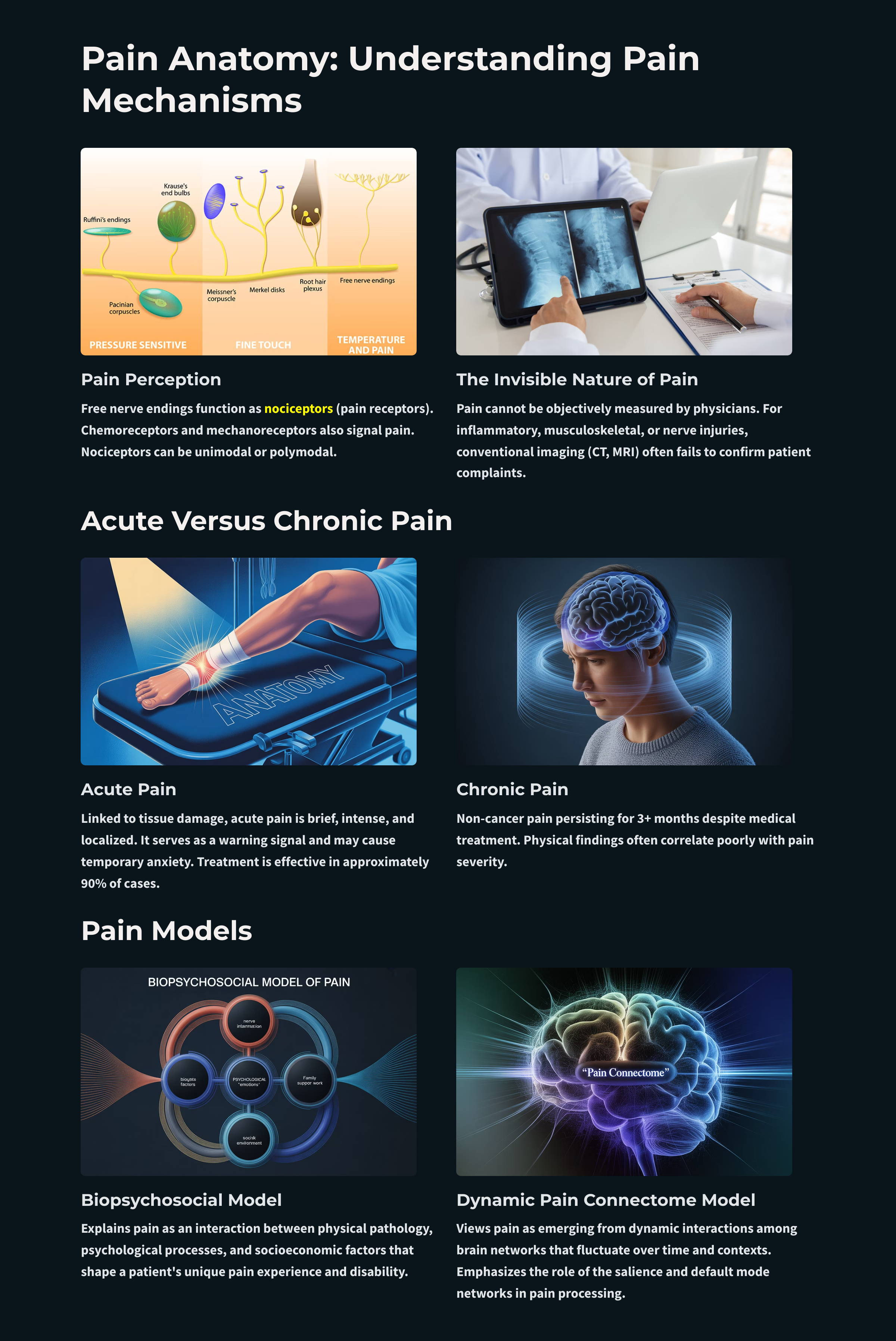
Glossary
A-alpha (Aα) fibers: large-diameter myelinated fibers that rapidly
conduct (80-120 meters per second) muscle length, contraction force, and light touch stimuli via the dorsal-column
medial-lemniscal and anterolateral systems.
A-beta (Aβ) fibers: large-diameter myelinated fibers that rapidly
conduct (35-75 meters per second) light touch stimuli via the dorsal-column medial-lemniscal and anterolateral systems.
A-delta (Aδ) fibers: small-diameter myelinated fibers found in skin and
mucous membranes strongly influence the sensory-discriminative component of pain. They rapidly conduct (5-30
meters per second) pain signals from unimodal mechanoreceptors via the anterolateral system to the thalamus and somatosensory
cortex.
acute pain: pain associated with tissue damage, involves brief, intense,
unpleasant sensations, warns of potential injury, and may produce transient anxiety.
allodynia: neuropathic pain syndrome where nonpainful stimuli, like light
touch, elicit severe pain.
angina pectoris: chest pain due to insufficient perfusion of the heart with blood.
anion: negative ion, for example, chloride (Cl
-).
anterior cingulate cortex (ACC): a frontal division that mediates executive functions and generates
affective motivation to initiate autonomic and motor responses to a condition that threatens body integrity; final
site for physical and psychological pain integration.
anterolateral system (ALS): also called the spinothalamic system, the ALS is a somatosensory pathway that
distributes most pain information to the brain.
arteriovenous anastomoses (AVAs): junctions of two or more vessels that
supply the same region, directly shunt blood from arterioles to venules, and help to regulate temperature.
ascending pain pathways: the dorsal-column medial-lemniscus system and anterolateral system
transmit information from peripheral receptors to the brain over a three-neuron pathway that includes a primary
afferent axon, a secondary projection neuron, and a tertiary neuron whose cell body lies in the thalamus.
BDNF: brain-derived neurotrophic factor, which reverses pain inhibition by neurons that release GABA
and glycine in lamina I of the spinal cord, where several pain pathways begin.
biopsychosocial model: Engel’s perspective that the complex interplay of psychological,
biological, and sociological factors results in health or illness.
bradykinin: a peptide that binds to nociceptors and increases their firing rate, worsening pain.
C-fiber: slowly-adapting small unmyelinated axon that slowly transmits pain information.
cerebral cortex: the layer of gray matter that covers the cerebral
hemispheres. The cerebral cortex consists of gray matter and white matter.
chronic pain: pain not due to cancer that has persisted for at least 3 months and has not responded to medical treatment.
cognitive-evaluative component: the meaning of pain is processed in the prefrontal cortex and the
insula.
Complex Regional Pain Syndrome (CRPS): a chronic progressive disease involving severe pain,
swelling, and skin lesions. The International Association for the Study of Pain divides CRPS into Type I, including Reflex Sympathetic Dystrophy (RSD) when nerve damage is absent, and Type II, causalgia, when nerve
damage is present.
cortisol: glucocorticoid produced by the adrenal cortex helps convert fat and protein to glucose
and reduces inflammation.
default mode network: a system including the medial prefrontal and posterior cingulate cortex, which is active during rest and self-referential thinking. It influences pain perception by integrating expectations, memories, and cognitive appraisals
descending pathways: pain-modulating systems that descend from the brain to the dorsal horn of the
spinal cord.
diathesis-stress model: the view that stressors interact with our inherited or acquired biological
vulnerabilities, called
diatheses, to produce medical and psychological symptoms.
dorsal-column medial-lemniscal system: a somatosensory pathway that
distributes touch information through the dorsal columns to the brain.
dorsal columns: part of the dorsal-column medial-lemniscus system. These columns are located toward each half of the spinal cord's back and innervated by sensory neurons that leave the dorsal root.
dorsal root: the upper sensory root of a spinal nerve.
dorsal root ganglion (DRG): cell body cluster in the dorsal root of a spinal nerve.
dynamic pain connectome model: pain is produced by fluctuating interactions between brain networks rather than isolated nociceptive regions. It emphasizes dynamic functional connectivity, involving sensory, cognitive, and affective processes.
endocannabinoid: a molecule related to THC that reduces the firing of
afferent fibers that transmit pain information to the spinal cord.
endorphin: an endogenous opioid polypeptide secreted by the pituitary gland and hypothalamus and
released synaptically by neurons.
episodic (recurrent) pain: pain that has recurred for more than 3 months. Like acute pain, these
episodes are brief. However, these episodes often produce psychological distress (like chronic pain), and patients
may present with anxiety, depression, helplessness, and stress.
fascia: soft tissue element of connective tissue.
fear-avoidance model: a framework explaining chronic pain development through pain-related fear, catastrophic thinking, avoidance behaviors, and physical deconditioning, reinforcing pain persistence.
first pain signal: the sensation of sharp, brief pain carried by Aβ fibers that warns that damage
has occurred.
free nerve ending: axon that projects to the skin without a specialized accessory structure and
detects pain and temperature information.
Gate-Control Theory of Pain: model that proposes cognitive-emotional mediation of pain and
interaction between ascending and descending pathways to modulate pain perception.
Gevirtz’s mediational model of muscle pain: the perspective that lack of assertiveness and
resultant worry each trigger sympathetic activation. Increased sympathetic efferent signals to muscle spindles and overexertion can produce a spasm in the muscle spindle's intrafusal fibers, increasing muscle spindle capsule pressure and causing myofascial pain.
histamine: a biogenic amine that produces swelling and binds to nociceptors and increases their firing
rate, worsening pain.
hypothalamic-pituitary-adrenal (HPA) axis: hormonal cascade that starts with signals from the
amygdala to the hypothalamus and ultimately targets the adrenal glands, releasing the hormones CRH, ACTH
(corticotropin), and cortisol.
insula: also called the insular cortex, is a structure deep within the lateral sulcus. The anterior
aspect is a limbic-associated cortex and generates a sensation and conscious emotional experience about the body’s
current state.
interoceptive and anterior insular cortex: structure deep within the lateral sulcus. The anterior
aspect is a limbic-associated cortex and generates a sensation and conscious emotional experience about the body’s
current state.
locus coeruleus: noradrenergic branch of the ascending reticular activating system, responsible for vigilance. Subnormal norepinephrine transmission may contribute to ADHD.
medial lemniscus pathway: brainstem pathway that distributes sensory information from the gracile and
cuneate nuclei to the thalamus.
microglia: a glial immune cell that removes dead or injured cells and releases BDNF (brain-derived
neurotrophic factor).
motivational-affective component: the unpleasantness of a painful stimulus is processed in the
anterior cingulate cortex of the frontal lobe.
mu (μ)
receptor: an opioid receptor that strongly binds enkephalins and beta-endorphins but weakly binds
dynorphins. Morphine and codeine bind to this receptor.
muscle spindle: receptors that detect muscle length, tension, and pressure.
naloxone: opiate antagonist that does not reverse analgesia due to stress.
Nav1.7: a sodium channel that acts as a "fuse," amplifying small nerve signals but not triggering full action potentials.
Nav1.8: aa sodium channel that functions as a "firecracker," generating most of the electrical current needed for neuronal firing.
nerve growth factor (NGF): a protein that regulates neuron growth in spinal and sympathetic ganglia and
probably plays a role in nociception.
nociceptor: receptor that detects stimuli that damage tissue or threaten tissue injury.
nucleus raphe magnus: serotonergic neurons that participate in the endogenous opiate system and
inhibit pain in the spinal cord. These neurons excite spinal cord interneurons by releasing serotonin. The
interneurons, in turn, inhibit C-fibers by releasing enkephalin, which binds to their terminal buttons and reduces
their release of transmitter. This process is called presynaptic inhibition.
nucleus reticularis paragigantocellularis (NRPG): neurons that excite spinal cord interneurons by
releasing norepinephrine. These interneurons inhibit neurons that project through a non-opioid polysynaptic pathway to the thalamus.
operant pain: pain that results from previous reinforcement of pain behaviors by the environment
(secondary gain).
palpation: examination by feeling or pressing with the hand.
periaqueductal gray (PAG): a midbrain region whose axons form excitatory synapses on neurons located in
the nucleus raphe magnus (NRM) and the nucleus reticularis paragigantocellularis (NRPG) in the medulla. The PAG
plays a role in the descending modulation of pain and control of defensive behavior.
phantom limb pain: chronic pain syndrome in which a patient perceives that an amputated or missing
limb is still intact.
polymodal nociceptor: nociceptor that responds to several stimuli.
prefrontal cortex: the most anterior frontal lobe division subdivided into dorsolateral,
medial, orbitofrontal, and anterior cingulate regions responsible for executive functions like attention and
planning.
presynaptic inhibition: a modulatory process where a neuron decreases neurotransmitter release by
reducing calcium ion entry.
primary hyperalgesia: supersensitivity to stimulation that affects joints, muscles, or skin that have
suffered damage or inflammation.
prostaglandin: lipid hormone that promotes swelling.
referred pain: pain perceived at a distance from the site of injury. For example, angina
pectoris.
respondent pain: pain due to an identifiable stimulus, like a dental drill.
This pain does not require previous learning.
salience network: a systemincluding the anterior insula and dorsal anterior cingulate cortex, detects and prioritizes relevant stimuli. It modulates pain by directing attention and integrating sensory and emotional responses.
second pain signal: the sensation of dull, aching pain carried by C-fibers reminds the body to
protect itself against further injury.
secondary hyperalgesia: supersensitivity to stimulation that affects the tissue surrounding joints,
muscles, or skin that have suffered damage or inflammation.
secondary somatosensory cortex (SII): a cortical region that receives direct projections from SI and
creates a superimposed map of both sides of the body.
sensory-discriminative component: the subjective feeling of pain (dull aching
or sharp) is processed in the secondary somatosensory cortex.
spinohypothalamic tract: a pathway that bypasses the reticular formation and projects to the
hypothalamus, amygdaloid complex, nucleus accumbens, and septum. This tract may contribute to our autonomic,
neuroendocrine, and emotional responses to noxious stimuli.
spinomesencephalic tract: a pathway that travels with the spinotectal tract and targets the
periaqueductal gray (PAG), locus coeruleus, and tectum. This tract may convey information concerning motivational
and emotional responses to pain.
spinoreticular tract: also called the paleospinothalamic tract. This pathway targets the reticular
formation and then the thalamic parafascicular nuclei and intralaminar nuclei. Axons from these thalamic nuclei
project to the anterior cingulate, amygdala, and hypothalamus. This tract may contribute to arousal and convey
information about our emotional response to pain, including suffering.
spinothalamic tract: also called the neospinothalamic tract. This pathway targets the thalamus's ventral posterior nucleus (VPN), like the dorsal-column medial-lemniscus system. VPN neurons project to
corresponding somatosensory cortical region. This tract may convey information about pain and temperature.
substance P: tachykinin neuropeptide functions as a neurotransmitter and neuromodulator that plays a role in transmitting peripheral pain signals to the CNS.
substantia gelatinosa: C-fibers transmit pain information to neurons in the spinal cord's dorsal horn that is relayed to the brainstem, thalamus, and cerebral cortex.
suzetrigine (Journavx): a Nav1.8 inhibitor approved for treating moderate to severe acute pain without opioid-related side effects.
substantia gelatinosa: C-fibers transmit pain information to neurons in the spinal cord's dorsal horn that is relayed to the brainstem, thalamus, and cerebral cortex.
synaptic plasticity mechanisms: Processes that modify synaptic strength and efficiency in response to activity, including long-term potentiation (LTP) and long-term depression (LTD), influencing learning, memory, and pain modulation.
trigeminal nerve: 5th cranial nerve that projects pain and temperature information concerning the
face to the same thalamic nuclei targeted by the spinothalamic and spinoreticular tracts. This cranial nerve also
controls biting, chewing, and swallowing.
trigger points: hyperirritable regions of taut bands of skeletal muscle in the muscle belly or
associated fascia.
unimodal nociceptor: nociceptor that responds to only one stimulus.
ventral posterior nucleus (VPN) of the thalamus: nucleus that integrates somatosensory information
from the opposite side of the face via the trigeminal nerve. The majority of VPN axons target the primary
somatosensory cortex (SI), while a minority target the secondary somatosensory cortex (SII) or the posterior
parietal cortex.
Wickramasekera’s Illness Behavior Syndrome: The patient assumes a role reinforced by a
healthcare system that treats chronic pain as if it were acute. This role consists of five components:
dramatizing complaints, progressive impairment, drug misuse, progressive dependency, and reduced income.
wind-up: pain after an injury has healed because interneurons continue to activate each other in the
absence of peripheral pain signals.
Test Yourself
Click on the ClassMarker logo to take 10-question tests over this unit without an exam password.

REVIEW FLASHCARDS ON QUIZLET
Click on the Quizlet logo to review our chapter flashcards.

Visit the BioSource Software Website
BioSource Software offers
Human Physiology, which satisfies BCIA's Human Anatomy and Physiology requirement, and
Biofeedback100, which provides extensive multiple-choice testing over BCIA's Biofeedback Blueprint.

Assignment
Now that you have completed this unit, explain why treating chronic
pain as if it acute can be debilitating. What is the clinical relevance
of descending pain-modulating pathways?
References
Advokat, C. D., Comaty, J. E., & Julien, R. M. (2022).
Julien's primer of drug action: A comprehensive guide to the actions, uses, and side effects of psychoactive drugs. Worth Publishers.
Andreassi, J. L. (2007).
Psychophysiology: Human behavior and physiological
response (5th ed.). Lawrence Erlbaum and Associates, Inc.
Apkarian, A. V., Sosa, Y., Sonty, S., Levy, R. M., Harden, R. N., Parrish, T. B., & Gitelman, D. R.
(2004).
Chronic back pain is associated with decreased prefrontal and thalamic gray matter density.
J
Neurosci, 24(46), 10410-10415. https://doi.org/10.1523/JNEUROSCI.2541-04.2004
Bear, M. F., Connors, B. W., & Paradiso, M. A. (2020).
Neuroscience:
Exploring the brain, enhanced edition (4th ed.). Wolters Kluwer.
Breedlove, S. M., & Watson, N. V. (2020).
Biological psychology: An introduction to behavioral, cognitive,
and clinical neuroscience (9th ed.)
. Sinauer Associates, Inc.
Coull, J. A., Beggs, S., Boudreau, D., Boivin, D., Tsuda, M., Inoue, K., Gravel, C., Salter, M. W., & De Koninck, Y. (2005).
BDNF from microglia causes the shift in neuronal anion gradient underlying neuropathic pain.
Nature, 438,
1017-1021. https://doi.org/10.1038/nature04223
Craig, A. D. (2003).
A new view of pain as a homeostatic emotion.
Trends in Neurosciences, 26(6), 303-307. https://doi.org/10.1016/s0166-2236(03)00123-1
Eisenberger, N. I., Lieberman, M. D., & Williams, K. D. (2003).
Does rejection hurt? An fMRI study of social exclusion.
Science,
302, 290-292. https://doi.org/10.1126/science.1089134
Gatchel, R. J. (2005).
Clinical essentials of pain management.
The American Psychological Association.
Heuther, S. E., McCance, K. L., & Brashers, V. L. (2020).
Understanding pathophysiology (7th ed.). Mosby.
Inoue, K., & Tsuda, M. (2018). Microglia in neuropathic pain: Cellular and molecular mechanisms and therapeutic potential.
Nature Reviews Neuroscience, 19(3), 138-152. https://doi.org/10.1038/nrn.2018.2
Jain, D., Burg, M., & Soufer, R. (1995).
Prognostic implications of mental stress induced silent ventricular dysfunction in patients with stable angina pectoris.
American Journal of Cardiology, 76, 30-35. https://doi.org/10.1016/s0002-9149(99)80796-6
Kalat, J. W. (2019).
Biological psychology (13th ed.). Cengage Learning.
Kingsley, R. E. (2000).
Concise textbook of neuroscience (2nd
ed.). Lippincott Williams & Wilkins.
Kronschläger, M. T., Drdia-Schutting, R., Gassner, M., Honsek, S. D., Teuchmann, H. L., & Sandkühler, J. (2016).
Gliogenic LTP spreads widely in nociceptive pathways.
Science, 354(6316), https://doi.org/1144-1148. 10.1126/science.aah5715
Kucyi, A., & Davis, K. D. (2015). The dynamic pain connectome.
Trends in Neurosciences, 38(2), 86-95. https://doi.org/10.1016/j.tins.2014.11.006
Kucyi, A., Moayedi, M., Weissman-Fogel, I., & Davis, K. D. (2018). Dynamic functional connectivity of the default mode network tracks daydreaming.
NeuroImage, 100, 471-480. https://doi.org/10.1016/j.neuroimage.2014.06.044
Lethem, J., Slade, P. D., Troup, J. D., & Bentley, G. (1983). Outline of a fear-avoidance model of exaggerated pain perception: I.
Behaviour Research and Therapy, 21(4), 401-408. https://doi.org/10.1016/0005-7967(83)90009-8
Li, S., & Tator, C. H. (2000).
Action of locally administered NMDA and AMPA/kainate receptor antagonists in spinal cord injury.
Neurol Res, 22(2), 171-180. https://doi.org/10.1080/01616412.2000.11758605
Lu, C., Yang, T., Zhao, H., Zhang, M., Meng, F., Fu, H., Xie, Y., Xu, H. (2021). Insular cortex is critical for the perception, modulation, and chronification of pain.
Neurosci. Bull., 32(2), 191-201. https://doi.org/10.1007/s12264-016-0016-y
Melton, L. (2004).
Aching atrophy. More than unpleasant, chronic pain shrinks the brain.
Scientific American,
290(1),
22-24. PMID: 14682034
Melzack, R. (1992).
Phantom limbs.
Scientific American,
266(4),
120-126. https://doi.org/10.1038/scientificamerican0492-120
Melzack, R., & Wall, P. D. (1965). Pain mechanisms: A new theory.
Science, 150, 971-979. https://doi.org/10.1126/science.150.3699.971
Menon, V., & Uddin, L. Q. (2010). Saliency, switching, attention and control: A network model of insula function.
Brain Structure and Function, 214, 655-667. https://doi.org/10.1007/s00429-010-0262-0
Milligan, E. D., & Watkins, L. R. (2009).
Pathological and protective roles of glia in chronic pain.
Nat
Rev Neurosci, 10(1), 23-36. https://doi.org/10.1038/nrn2533
Meulders, A. (2019). Fear in the context of pain: Lessons learned from 100 years of fear conditioning research.
Behaviour Research and Therapy, 126, 103573. https://doi.org/10.1016/j.brat.2019.103573
Mogil, J. S., Ritchie, J., Smith, S. B., Strasburg, K., Kaplan, L., Wallace, M. R., & Melancon, S. M. (2005). Melanocortin-1 receptor gene variants affect pain and mu-opioid analgesia in mice and humans.
Journal of Medical Genetics, 42(7), 583-587. https://doi.org/10.1136/jmg.2004.027698
Peper. E., Harvey, R., & Fass, N. (2020).
Tech stress: How technology is hijacking our lives, strategies for coping, and pragmatic ergonomics. North Atlantic Books.
Petrovic, P., Kalso, E., Petersson, K. M., & Ingvar, M. (2002).
Placebo and opioid analgesia--Imaging a shared neuronal network.
Science,
295, 1737-1740. https://doi.org/10.1126/science.1067176
Ranney, D. (2001). Paper presented at the Ontario Inter-Urban Pain
Conference.
Sherman, R. A. (2004).
Pain assessment and intervention. Association for Applied Psychophysiology and Biofeedback.
Taylor, S. E. (2021).
Health psychology (11th ed.)
. McGraw-Hill.
Tortora, G. J., & Derrickson, B. H. (2021).
Principles of anatomy and
physiology (16th ed.)
. John Wiley & Sons, Inc.
Vlaeyen, J. W. S., & Linton, S. J. (2000). Fear-avoidance and its consequences in chronic musculoskeletal pain: A state of the art.
Pain, 85(3), 317-332. https://doi.org/10.1016/S0304-3959(99)00242-0
Vlaeyen, J. W. S., Kole-Snijders, A. M. J., Boeren, R. G. B., & van Eek, H. (2016). Fear of movement/(re)injury in chronic low back pain and its relation to behavioral performance.
Pain, 62(3), 363-372. https://doi.org/10.1016/0304-3959(95)00272-3
Wager, T. D., Rilling, J. K., Smith, E. E., Sokolik, A., Casey, K. L.,
Davidson, R. J., Kosslyn, S. M., Rose, R. M., & Cohen, J. D. (2004).
Placebo-induced changes in fMRI in the anticipation and experience of pain.
Science,
303, 1162-1167. https://doi.org/10.1126/science.1093065
Wickramasekera, I. A. (1988).
Clinical behavioral medicine: Some concepts
and procedures. Plenum Press.
Wilson, J. (2003).
Biological foundations of human behavior. Wadsworth/Thompson Learning.
Zeng, Q., Xie, W., Luckemeyer, D. D.,
Lay, M., Wang, X.-W., Dong, X., Limjunyawong, N., Ye, Y., Zhou, F.-Q., Strong, J. A., Zhang, J.-M., & Dong, X. (2021). Synchronized cluster firing, a distinct form of sensory neuron activation, drives spontaneous pain.
Neuron. https://doi.org/10.1016/j.neuron.2021.10.019
Zunhammer, M., Spisák, T., Wager, T. D., Bingel, U., & The Placebo Imaging Consortium (2021). Meta-analysis of neural systems underlying placebo analgesia from individual participant fMRI data.
Nature Communications, 12 (1391). https://doi.org/10.1038/s41467-021-21179-3













.jpg)














.jpg)





